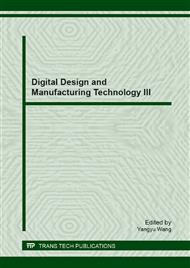[1]
C. Basaran, M. Lin. Damage mechanics of electromigration induced failure. Mechanics of Materials, Vol. 40(2007), pp.66-79.
DOI: 10.1016/j.mechmat.2007.06.006
Google Scholar
[2]
J. R. Black. Mass transport of aluminum by momentum exchange with conducting electrons. The Sixth Annual Reliability Physics Symposium Proceedings, Los Angeles (1968), pp.148-159.
DOI: 10.1109/relphy.2005.1493053
Google Scholar
[3]
K. N. Tu. Recent advances on electromigration in every-large-scale-integration of interconnects. Journal of Applied physics, Vol. 94(2003), pp.5451-5473.
DOI: 10.1063/1.1611263
Google Scholar
[4]
S. W. Liang, T. L. Shao, C. Chen. 3-D simulation on current density distribution in flip-chip solder joints with thick Cu UBM under current Stressing. Proceedings of 55th Electronic Components and Technology Conference, Lake Buena Vista (2005).
DOI: 10.1109/ectc.2005.1441971
Google Scholar
[5]
D. Dalleau, K. Weide-Zaage. Three-dimensional voids simulation in chip-level metallization structures: a contribution to reliability evaluation. Microelectronics Reliability, Vol. 41(2001), pp.1625-1630.
DOI: 10.1016/s0026-2714(01)00151-2
Google Scholar
[6]
K. Sasagawa, M. Hasegawa, M. Saka, H. Abe. Prediction of electromigration failure in passivated polycrystalline line. Journal of Applied Physics, Vol. 91 (2002), pp.9005-9014.
DOI: 10.1063/1.1475354
Google Scholar
[7]
V. Sukharev, E. Zschech. A model for electromigration-induced degradation mechanisms in dual-inlaid copper interconnects: Effect of interface bonding strength. Journal of Applied Physics, Vol. 96 (2004), pp.6337-6343.
DOI: 10.1063/1.1805188
Google Scholar
[8]
C. M. Tan, Y. J. Hou, W. Li. Revisit to the finite element modeling of electromigration for narrow interconnects. Journal of Applied Physics, Vol. 102 (2007), pp.1-7.
DOI: 10.1063/1.2761434
Google Scholar
[9]
Y. Liu, L. Liang, S. Irving, et al. 3D modeling of electromigration combined with thermal-mechanical effect for IC device and package. Microelectronics Reliability, Vol. 48 (2008), pp.811-824.
DOI: 10.1016/j.microrel.2008.03.021
Google Scholar
[10]
L.H. Liang, Y. X. Zhang, X. F. Chen. A new algorithm for EM analysis considering multiple driving forces mechanism. Proceedings of 10th Electronics Packaging Technology Conference, Singapore (2008), pp.1138-1144.
DOI: 10.1109/eptc.2008.4763582
Google Scholar
[11]
D. Dalleau 3-D time-depending simulation of void formation in metallization structures. Doctor Dissertation, Hannover University, (2003).
Google Scholar


